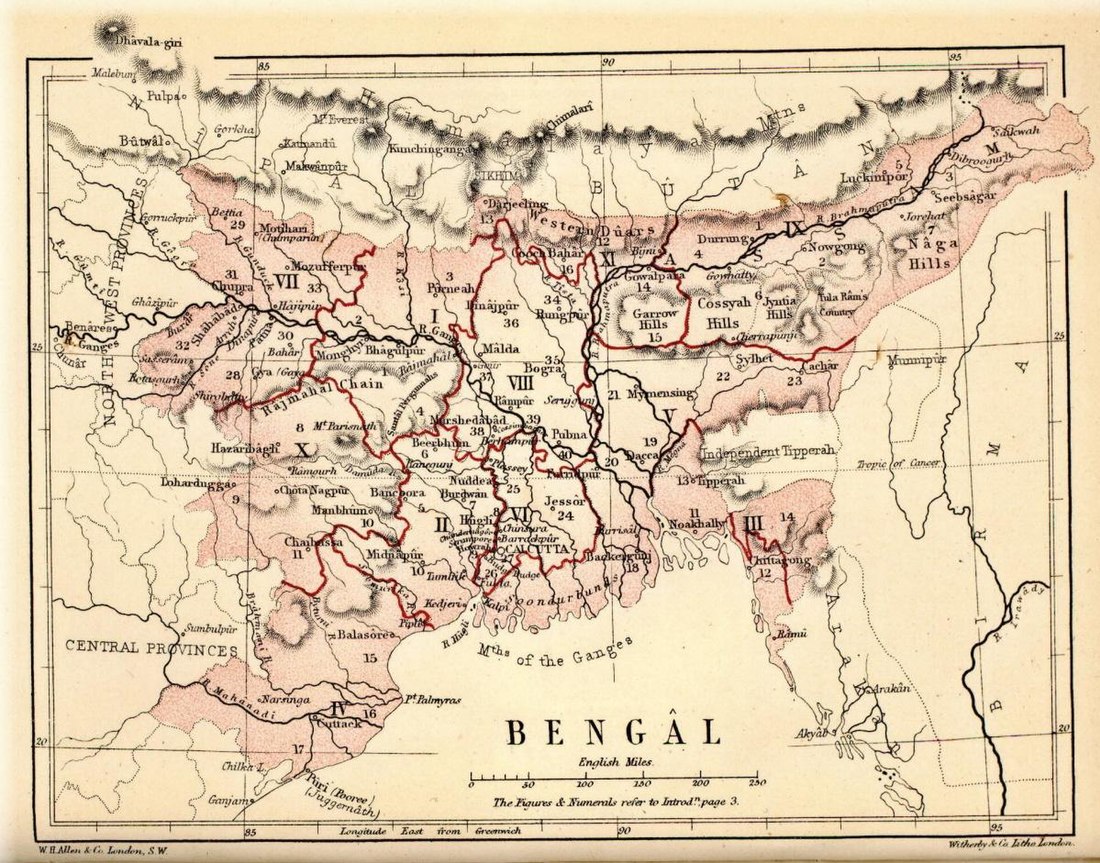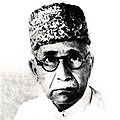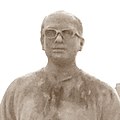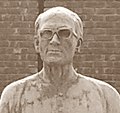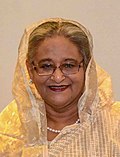Top Qs
Timeline
Chat
Perspective
List of rulers of Bengal
From Wikipedia, the free encyclopedia
Remove ads
This is a list of rulers of Bengal. For much of its history, Bengal was split up into several independent kingdoms, completely unifying only several times. In ancient times, Bengal consisted of the kingdoms of Pundra, Suhma, Vanga, Samatata and Harikela.
This article has multiple issues. Please help improve it or discuss these issues on the talk page. (Learn how and when to remove these messages)
|
In the 4th century BCE, during the reign of the Nanda Empire, the powerful rulers of Gangaridai sent their forces consisting of war elephants which led to the withdrawal of Alexander the Great from the Indian subcontinent.[1]
With the rise of Gopala in 750 AD, Bengal was united once more under the Buddhist and Shaivite Pala Empire. The Pala period is considered as one of golden eras of Bengali history as it brought stability and prosperity to Bengal after centuries of Civil War, created outstanding works of art and architecture, proto-Bengali language developed under them including its first literary work, the Charyapada and so on. They ruled Bengal until the 12th century, before being succeeded by the Buddhist and Hindu Chandra dynasty, Sena dynasty and Deva dynasty. The rule of the Sena and Deva dynasty extended over various parts of Bengal,[2][3] until the arrival of Muhammad bin Bakhtiyar Khalji as part of the Ghurid Invasion of Bengal.[4] [citation needed]
In the early 13th century, Muhammad bin Bakhtiyar Khalji conquered the Western and parts of Northern Bengal,[5] and established the first Muslim kingdom in Bengal.[6] The Delhi Sultanate, under various Islamic dynasties such as the Mamluk Sultanate, the Khalji dynasty, the Turko-Indian Tughlaq dynasty, the Sayyid dynasty and the Lodi dynasty ruled over various parts Bengal for some 300 years, interrupted and frequently challenged by local muslim rulers of Bengal.[7][8]
The Bengal Sultanate, a major trading nation in the world,[9] was founded in 1342 by Shamsuddin Ilyas Shah, after he united Satgaon, Lakhnauti and Sonargaon.[10] The Ilyas Shahi dynasty ruled Bengal for nearly 150 years. The Hussain Shahi dynasty founded by Alauddin Husain Shah, reached its greatest territorial extent which saw the extension of the sultanate from modern Bihar and Odisha in the west, to Kamaraupa and the port of Chittagong in the east, witnessing the arrival of the earliest Portuguese merchants.[8][11]
Remove ads
Ancient Bengal
Summarize
Perspective
Ancient geopolitical divisions

The founders of Angas, Vangas, Kalingas, Pundras, Odras and Suhmas shared a common ancestry. They were all adopted sons of a king named Bali, born by a sage named Gautama Dirghatamas, who lived in Magadha close to the city of Girivraja.[12]
- Bengal from c. 1100 to c. 600 BCE

- Bengal from c. 600 to c. 350 BCE

- Bengal in c. 350 BCE

Anga kingdom (c. 1100–530 BCE)
The earliest mention occurs in the Atharvaveda (V.22.14) where they are listed alongside the Magadhas, Gandharis and the Mujavatas.[13] Anga was annexed by Magadha in the time of Bimbisara. This was the one and only conquest of Bimbisara.[14]
Known Anga rulers include:
- Maharaj Anga – (founder of the kingdom and son of King Bali)
- Romapada
- Brihadratha
- Angaraj Karna
- Vrishaketu – (son of Karna)
- Tamralipta
- Lomapada
- Chitraratha
- Vrihadratha
- Vasuhoma
- Dhatarattha
- Dhadivahana
- Brahmadatta – (last king of Anga kingdom)
Vanga kingdom (c. 1100–340 BCE)
Vanga was an ancient kingdom and geopolitical division on the Ganges delta. It was located in southern Bengal, with the core region including present-day southwestern Bangladesh and southern West Bengal (India).[15]
Known Vanga rulers are:
- Samudrasena
- Chandrasena
- Karna
- Bhagabhatta
Pundra kingdom (c. 1100–340 BCE)
Pundravardhana or Pundra Kingdom, was an ancient kingdom, that included parts of present-day Rajshahi and Rangpur Divisions of Bangladesh as well as the West Dinajpur district of West Bengal in India.[16][17]
Known Pundra rulers are:
Suhma kingdom (c. 1100–340 BCE)
Suhma kingdom was an ancient state during the Vedic period on the eastern part of the Bengal.This kingdom was mentioned in the epic Mahabharata along with its neighbouring kingdom Prasuhma.[18]
Videha dynasty of Mithila (Tirabhukti) (c. 1100–700 BCE)
Tirabhukti or Mithila region is bounded by the Mahananda River in the east, the Ganges in the south, the Gandaki River in the west and by the foothills of the Himalayas in the north.[19]
Mithila region firstly ruled by Videha dynasty. There were 52 Janaka (kings) ruled Videha dynasty of Mithila-[20]
- Mithi (founder of Mithila and the first Janaka)[21]
- Udavasu
- Nandivardhana
- Suketu
- Devarata
- Brihadvrata
- Mahavira
- Sudhriti
- Dristaketu
- Haryasva
- Maru
- Pratindhaka
- Kritiratha
- Devamidha
- Vibhuta
- Mahidhrata
- Kirtirata
- Mahorama
- Swarnorama
- Hrisvaroma
- Seeradhwaja
- Bhaanumaan
- Shatadyumn
- Shuchi
- Oorjnaamaa
- Kriti
- Anjan
- Kurujit
- Arishtnemi
- Shrutaayu
- Supaarshwa
- Srinjaya
- Kshemaavee
- Anenaa
- Bhaumarath
- Satyarath
- Upagu
- Upagupt
- Swaagat
- Swaanand
- Suvarchaa
- Supaarshwa
- Subhaash
- Sushrut
- Jaya
- Vijaya
- Rit
- Sunaya
- Veetahavya
- Dhriti
- Bahulaashwa
- Kriti (last King of Videha or Janaka dynasty, Kirti Janak was atrocious ruler who lost control over his subjects. He was dethroned by public under leadership of Acharyas (Learned Men).
During this period of fall of Videha dynasty, the famous republic of Licchavi was rising in Vaishali and Mithila region came under control of Licchavi clan of Vajji confederacy in around eighth century BCE.[22]
Gangaridai kingdom (c. 350–100 BCE)
Gangaridae is a term used by the ancient Greco-Roman writers to describe a people or a geographical region of the ancient Indian subcontinent. Some of these writers state that Alexander the Great withdrew from the Indian subcontinent because of the strong war elephant force of the Gangaridai. However, the geographical region was annexed and governed by the Nanda Empire at the time.
A number of modern scholars locate Gangaridai in the Ganges Delta of the Bengal region, although alternative theories also exist. Gange or Ganges, the capital of the Gangaridai (according to Ptolemy), has been identified with several sites in the region, including Chandraketugarh and Wari-Bateshwar.[23]
Remove ads
Magadha dynasties of Bengal
Summarize
Perspective

Brihadratha dynasty (c. 1700–682 BCE)
- Rulers-
(Ripunjaya was the last ruler of dynasty, dethorned by Pradyota in 682 BCE)
Pradyota dynasty (c. 682–544 BCE)
- Rulers-
(Varttivarddhana was last ruler of dynasty dethroned by Bimbisara in 544 BCE)
Haryanka dynasty (c. 544–413 BCE)
- Rulers-
(Nāgadāsaka was last ruler of dynasty overthrowed by Shishunaga in 413 BCE)
Shishunaga dynasty (c. 413–345 BCE)
- Rulers-
(Mahanandin lost his empire by his illegitimate son Mahapadma Nanda in 345 BCE)
Nanda Empire (c. 345–322 BCE)
- Rulers-
(Dhana Nanda lost his empire to Chandragupta Maurya after being defeated by him in 322 BCE)
Maurya Empire (c. 322–184 BCE)
- Rulers-
(Brihadratha was the last ruler of dynasty, dethroned by Pushyamitra Shunga in 185 BCE)
Shunga Empire (c. 185–73 BCE)
- Rulers-
(Devabhuti was the last ruler of dynasty dethroned by, dethroned Vasudeva Kanva in 73 BCE)
Kanva dynasty (c. 73–28 BCE)
- Rulers-
(Susarman was the last ruler of dynasty, dethroned by Simuka of Satavahana Empire)
Remove ads
Classical Era
Summarize
Perspective
Chandra dynasty (c. 202–1050 CE)
The Chandra Kingdom was a Kayastha kingdom, which ruled the Vanga-Samatata region of Bengal, as well as northern Arakan. Later it was a neighbor to the Pala Empire to the north. Rulers of Chandra kingdom were followers of Hinduism.[24][25]
- Rulers-
Pushkarana Kingdom (c. 4th century CE)
- Simhavarman
- Chandravarman
Gupta Empire (c. 240–550 CE)
- Rulers-
- Sri-Gupta I (240–280), founder of dynasty
- Ghatotkacha (280–319)
- Chandra Gupta I (320–335)
- Samudra Gupta (335–380)
- Rama Gupta (6 Months)
- Chandra Gupta II (Chandragupta Vikramaditya) (380–413/415)
- Kumara Gupta I (415–455)
- Skanda Gupta (455–467)
- Puru Gupta(467–473)
- Kumara Gupta II (473–476)
- Buddha Gupta (476–495)
- Narasimha Gupta(495–540)
- Vainyagupta (~507)
- Kumara Gupta III (500–540)
- Vishnugupta (540–550), last imperial Gupta ruler.
Independent Vanga Kingdom (c. 525–575 CE)
- Gopachandra
- Dharmadiya
- Samachardeva
Jaintia kingdom (c. 525–1835 CE)
Old dynasty rulers
- Urmi Rani (?–550)
- Krishak Pator (550–570)
- Hatak (570–600)
- Guhak (600–630)
Partitioned Jaintia rulers
- Jayanta (630–660)
- Joymalla (660–?)
- Mahabal (?)
- Bancharu (?–1100)
- Kamadeva (1100–1120)
- Bhimbal (1120)
Brahmin dynasty rulers
- Kedareshwar Rai (1120–1130)
- Dhaneshwar Rai (1130–1150)
- Kandarpa Rai (1150–1170)
- Manik Rai (1170–1193)
- Jayanta Rai (1193–1210)
- Jayanti Devi
- Bara Gossain
New dynasty rulers
- Prabhat Ray Syiem Sutnga (1500–1516)
- Majha Gosain Syiem Sutnga (1516–1532)
- Burha Parbat Ray Syiem Sutnga (1532–1548)
- Bar Gosain Syiem Sutnga I (1548–1564)
- Bijay Manik Syiem Sutnga (1564–1580)
- Pratap Ray Syiem Sutnga (1580–1596)
- Dhan Manik Syiem Sutnga (1596–1612)
- Jasa Manik Syiem Sutnga (1612–1625)
- Sundar Ray Syiem Sutnga (1625–1636)
- Chota Parbat Ray Syiem Sutnga (1636–1647)
- Jasamanta Ray Syiem Sutnga (1647–1660)
- Ban Singh Syiem Sutnga (1660–1669)
- Pratap Singh Syiem Sutnga (1669–1678)
- Lakshmi Narayan Syiem Sutnga (1678–1694)
- Ram Singh Syiem Sutnga I (1694–1708)
- Jay Narayan Syiem Sutnga (1708–1731)
- Bar Gosain Syiem Sutnga II (1731–1770)
- Chattra Singh Syiem Sutnga (1770–1780)
- Yatra Narayan Syiem Sutnga (1780-1785)
- Bijay Narayan Syiem Sutnga (1785–1786)
- Lakshmi Singh Syiem Sutnga (1786-1790)
- Ram Singh Syiem Sutnga II (1790–1832)
- Rajendra Singh Syiem Sutnga (1832–1835)[26][27]
Gauda kingdom (c. 550–626 CE)
- Rulers-
Pushyabhuti (Vardhana) Empire (c. 606–647 CE)
- Rulers of Bengal-
- Harshavardhana (606–647), unified Northern India and ruled it for over 40 years, he was the last non-Muslim emperor to rule a unified Northern India
Khadga dynasty (c. 625–730 CE)
- Rulers-
Bhadra dynasty (6th to 7th century)
The Bhadra dynasty was a Bengali Hindu royal house of Brahmin origin, their rule flourished during the first half of the 7th century, though little is known about their history. The kings of the dynasty bore names with the suffix "Bhadra".
- Known rulers are-
- Narayanabhadra
- Jyeshthabhadra
Mallabhum kingdom (c. 694–1147 CE)
- Rulers-
Remove ads
Post-Classical era
Summarize
Perspective
Pala Empire (c. 750–1161 CE)
Most of the Pala inscriptions mention only the regnal year as the date of issue, without any well-known calendar era. Because of this, the chronology of the Pala kings is hard to determine.[30] Based on their different interpretations of the various epigraphs and historical records, different historians estimate the Pala chronology as follows:[31]
Sena dynasty (c. 1070–1230 CE)
Sena dynasty ruled southwestern Bengal from 1070 and ruled East Bengal until 1230. Vijaya Sena conquered entire Bengal by 1154 CE.
- Rulers-
- Hemanta Sena (1070–1096)
- Vijaya Sena (1096–1159)
- Ballala Sena (1159–1179)
- Lakshmana Sena (1179–1206)
- Vishvarupa Sena (1206–1225)
- Keshava Sena (1225–1230)
Deva dynasty (c. 1150–1294 CE)
- List of rulers is disputed-
- Purushottamadeva
- Madhusudanadeva
- Vasudeva
- Shantideva
- Viradeva
- Anandadeva
- Bhavadeva
- Damodaradeva (1231–1243)
- Dasharathadeva (1243–1281)
- Vikramadityadeva (1281–1294)
Remove ads
Delhi Sultanate period
Summarize
Perspective
Khalji dynasty
The Khalji dynasty of Bengal (c. 1204-27) were initially representatives of the Ghurid Empire, later becoming independent, although at times being subordinate to the Delhi Sultanate.
Governors of Bengal under Mamluk dynasty (1227–1287)
Governors of Bengal under the Mamluk dynasty of the Delhi Sultanate.
House of Balban
The House of Balban (c. 1287–1324) came about as a result of Mamluk governor Nasiruddin Bughra Khan declaring independence.
Governors of Bengal under Tughlaq dynasty (1324–1338)
Remove ads
Bengal Sultanate era
Summarize
Perspective
Independent Sultans of Bengal during Tughlaq dynasty (1338–1352)
Ilyas Shahi dynasty (1352–1414)
House of Raja Ganesha (1414–1435)
Restored Ilyas Shahi dynasty (1435–1487)
Habshi rule (1487–1494)
Hussain Shahi dynasty (1494–1538)
Governors of Bengal under Sur Empire (1532–1556)
Muhammad Shah dynasty (1554–1564)
Karrani dynasty (1564–1576)
- Isa Khan
- Masum khan
- Musa khan
- Fazal Ghazi
- Bahadur Ghazi
- Khwaja Usman Khan Lohani
- Bayezid Karrani
- Pratapaditya
- Bir Hambir
- Kedar Roy
- Chad Ray
- Mukundaram Roy
Remove ads
Mughal Rulers
Remove ads
Mughal Subahdars of Bengal Subah (1574–1717)
During the reign of Akbar
During the reign of Jahangir
During the reign of Shah Jahan
During the reign of Aurangzeb
Remove ads
Medieval Hindu dynasties of Bengal
Koch dynasty (c. 1515–1949 CE)
Rulers of undivided Koch dynasty (c. 1515–1586 CE)
- Biswa Singha (1515–1540 CE)
- Nara Narayan (1540–1586 CE)
Rulers of Koch Behar (c. 1586 – 1949)
- Lakshmi Narayan
- Bir Narayan
- Pran Narayan
- Basudev Narayan
- Mahindra Narayan
- Roop Narayan
- Upendra Narayan
- Devendra Narayan
- Dhairjendra Narayan
- Rajendra Narayan
- Dharendra Narayan
- Harendra Narayan
- Shivendra Narayan
- Narendra Narayan
- Nripendra Narayan
- Rajendra Narayan II
- Jitendra Narayan (father of Gayatri Devi)
- Jagaddipendra Narayan (ruled till 1949)[40]
Kingdom of Bhurshut (c. 16th–18th century)
- Maharaja Shivanarayan
- Maharaja Rudranarayan, Maharaja (16th century)
- Bhavashankari, Maharani (16th century)
- Pratapnarayan, Maharaja (17th century)
- Naranarayan, Maharaja (17th century)
- Lakshminarayan, Maharaja (c. 1695–1712)
Maharaja of Lower Bengal region
- Known rulers are
- Raja Sitaram Ray (1688–1714 CE)
Maharaja of Bhawal region
Rulers of Gazipur and Madhupur forest are in central Bangladesh.
Nawabs of Bengal
Summarize
Perspective
Independent Nawabs of Bengal (1717–1757 CE)
Shamsher Gazi's Kingdom

The advent of the British East India Company with its "exploitation and oppression" alongside zamindari subjugation, made life of the peasants and farmers difficult and despondent. Shamsher Gazi's efficient rule freed them of this control. With the granting of rent exemption to the peasants, he managed to govern the economy in an appropriate manner, leading to the reduction of the prices of essential commodities.[41] He was generous to both the Hindus and Muslims. He had ponds dug, naming them after himself, and built many schools in and outside his capital Jagannath Sonapur.[42] 'Kaiyar Sagar' was one of the larger ponds in the area.[43]
Nawabs of Bengal under East India Company (1757–1881 CE)
Nawabs of Murshidabad
Remove ads
East India Company governors in Bengal
Summarize
Perspective
Governors of British East India Company in Bengal (1757–1773)
- Robert Clive 1757 – 1760
- Henry Vansittart 1760 – 1764
- Robert Clive (again) 1765 – 1766
- Harry Verelst 1767 – 1769
- John Cartier 1769 – 1772
- Warren Hastings 1772 – 1773
As per the treaty of Allahabad in 1765, the British East India Company (BEIC) was given the right to collect revenue (Diwani right). From 1769, the company collected revenue from Bengal.
Governors-General of British East India Company in Bengal – Dual government (1773–1793)
Following the Regulating Act 1773, the Governor of Bengal was officially called Governor-General of Fort William.
- Warren Hastings 1773 – 1785
- Charles Cornwallis 1786 – 1793
Governors-General of British East India Company in Bengal (1793–1833)
In 1793, the British East India Company abolished Nizamat, i.e. local rule by Mughal emperor- appointed Nawabs and annexed Bengal.
- Sir John Shore 1793 – 1798
- Richard Wellesley 1798 – 1805
- Charles Cornwallis 1805 – 1805
- Sir George Barlow, 1st Baronet 1805 – 1807
- Gilbert Elliot-Murray-Kynynmound, 1st Earl of Minto 1807 – 1813
- Francis Rawdon-Hastings, 1st Marquess of Hastings 1813 – 1823
- John Adam 1823 – 1823
- William Amherst, 1st Earl Amherst 1823 – 1828
- William Butterworth Bayley 1828 – 1828
- Lord William Bentinck 1828 – 1833
Governor-Generals of British East India Company (1833–1858)
As per Charter Act 1833, the Governor-General of Bengal would be called Governor-General of India
- Lord William Bentinck 1833 – 1835
- Charles Metcalfe, 1st Baron Metcalfe 1835 – 1836
- George Eden 1836 – 1842
- Edward Law 1842 – 1844
- William Bird 1844 – 1844
- Henry Hardinge 1844 – 1848
- James Broun-Ramsay 1848 – 1856
- The Viscount Canning 1856 – 1858
Remove ads
British Raj era
Summarize
Perspective


With the establishment of the Empire of India in 1858, the position of Governor-General was replaced with Governor-General and Viceroy of India. Calcutta, the capital of Bengal also became the capital of India. As a result, the position of Lieutenant-Governor of Bengal was established to look after provincial matters.
Lieutenant-Governors (1858–1912)
- Frederick James Halliday 1858–1859
- John Grant 1859–1862
- Sir Cecil Beadon 1862–1866
- Sir William Grey 1866–1871
- George Campbell 1871–1874
- Sir Richard Temple 1874–1877
- Sir Ashley Eden 1877–1879
- Steuart Bayley 1879–1882
- Sir Augustus Thompson 1882–1885
- Horace Cockerell 1885–1887
- Sir Steuart Bayley 1887–1890
- Charles Eliott 1890–1893
- Anthony MacDonnell 1893–1895
- Alexander Mackenzie 1895–1897
- Charles Cecil Stevens 1897–1898
- Sir John Woodburn 1898–1902
- James Bourdillon 1902–1903
- Sir Andrew Fraser 1903–1905
- Sir Andrew Fraser (Western Bengal); Sir Bampfylde Fuller (Eastern Bengal and Assam) 1905–1906
- Francis Slacke (Western Bengal) 1906–1908; Lancelot Hare (Eastern Bengal and Assam) 1906–1911
- Sir Edward Baker (Western Bengal) 1908–1911
- Sir William Duke (Western Bengal); Sir Charles Stuart Bayley (Eastern Bengal and Assam) 1911–1912
Governors (1912–1947)
In late 1911, the Indian Government decided to move the capital to New Delhi. As a result, the Governorship of Bengal Presidency was now necessary.
Prime Minister of Bengal (1937–1947)
The Government of India Act 1935 introduced provincial autonomy in India and the position of Chief Minister or Premier of Bengal became very prominent.
Office holders

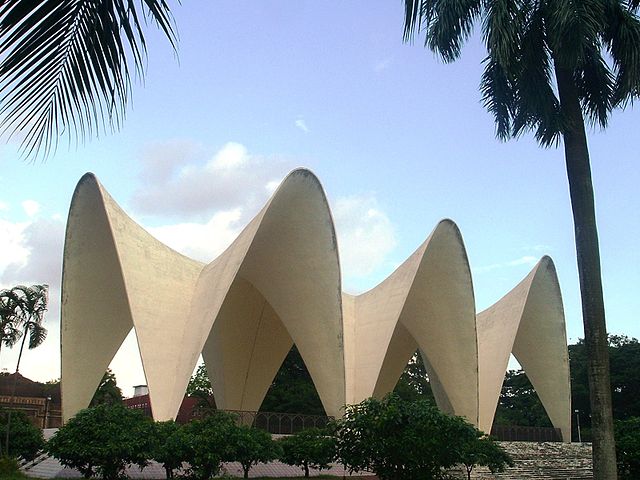
Subsequently, all three Bengali chief ministers moved to East Pakistan, where they continued to be influential statesmen. Nazimuddin and Suhrawardy became Prime Ministers of Pakistan, while Huq served as the chief minister and governor of East Pakistan.
After Independence of India and Pakistan
Summarize
Perspective
British colonial period ended when India and Pakistan became independent nations in 1947. Bengal fell into two parts – one in India, named West Bengal and the other part in Pakistan as East Bengal, later renamed to East Pakistan in 1955.
East Bengal (1947–1955)
Governors of East Bengal (1947–1955)
Political Party
Legend
Acting Governor
- A.S.M. Akram was appointed Acting Governor during the leave of absence of Sir Frederick Chalmers Bourne
- Abdur Rahman Siddiqui was appointed Acting Governor during the leave of absence of Sir Feroz Khan Noon
- With the dismissal of the United Front Ministry in East Bengal, Governor General Malik Ghulam Muhammad decided to enforce Governor's Rule in the province and appointed Iskander Mirza as Governor
- Sir Thomas Hobart Ellis was appointed Acting Governor when Iskander Mirza was taken into the central cabinet as Minister
- Muhammad Shahabuddin was appointed after Acting Governor after Sir Thomas Hobart Ellis
- Justice Shahabuddin resigned due to differences of opinion about the restoration of parliamentary government in East Bengal
- Justice Amiruddin Ahmad, Chief Justice of Dhaka High Court, was appointed acting Governor on the resignation of Justice Muhammad Shahabuddin
East Pakistan (1955–1971)
Governors of East Pakistan (1955–1971)
In late 1955, the prime minister Muhammad Ali Bogra initiated the One Unit policy which resulted in East Bengal province being renamed to East Pakistan.
Political Party
Legend
Acting Governor
- Justice Amiruddin Ahmad, Chief Justice of Dhaka High Court, was appointed acting Governor on the resignation of Justice Muhammad Shahabuddin
- President Iskander Mirza removed A. K. Fazlul Huq as governor on 31 March 1958 on the advice of the Noon cabinet for allegedly overstepping his limits as a constitutional Governor. Huq had dismissed Ataur Rahman's Ministry of Awami League that had not been defeated on the floor of the House, and had installed Mr. Abu Hussain Sarkar of his own party Krishak Sramik Party as Chief Minister.
- Muhammad Hamid Ali, Chief Secretary to the Governor of East Pakistan, was appointed Acting Governor in pursuance of the provisions of Article 70 of the Constitution following the removal of Sher-e-Bangla A. K. Fazlul Huq from the office
- Sultanuddin Ahmad was removed from office on 10 October 1958 soon after the promulgation of Martial Law in Pakistan on 7 October
- Syed Hashim Raza was Acting Governor of the province during the absence of General Azam Khan's official visit to West Germany
- Unable to cope with the political problems of East Pakistan, Ghulam Faruque Khan resigned from office.
- With the promulgation of Martial Law throughout Pakistan and the abrogation of the constitution in the evening of 25 March, Mirza Nurul Huda's tenure of governorship came to an abrupt end after just 60 hours.
- On 25 March 1969 General A. M. Yahya Khan proclaimed martial law and divided the country into two administrative zones- West Pakistan (Zone 'A') and East Pakistan (Zone 'B'). Major general Muzaffaruddin was the GOC of the 14 Division, became Martial Law Administrator, Zone 'B'. On 8 April 1969, Yahya Khan issued an order directing that the Martial Law Administrators of Zone 'A' and 'B' would perform the functions and powers of the Governors of West and East Pakistan respectively. Thus Major general Muzaffaruddin became Martial Law Administrator and also exercised the powers and functions of Governor of East Pakistan.
- Lieutenant general Sahabzada Yaqub Khan was appointed as Martial Law Administrator of Zone 'B' and exercised the powers and functions of the Governor of East Pakistan.
- On 8 April 1969, President Yahya Khan issued an order directing that the Martial Law Administrators would perform the functions and powers of the Governor. However, a notification issued by the cabinet secretariat on 1 September 1969 cancelled the order of 8 April 1969 and directed Martial Law Administrators to refrain from performing the functions of Governor in their respective provinces with immediate effect. Lt. General Yaqub Khan remained Martial Law Administrator until Vice Admiral S. M. Ahsan took over as the new Governor of East Pakistan on 1 September 1969
- Lt. general Sahabzada Yaqub Khan was made the "head of civil administration in the province" and exercised the functions and powers of Governor from 1 March 1971 until the arrival of Lt. general Tikka Khan on 7 March 1971.
- Abdul Motaleb Malik along with his cabinet resigned on 14 December after realizing that Pakistani defeat was imminent and sought refuse in Hotel Intercontinental, seeking the protection of the Red Cross flag.
- Lt. general A. A. K. Niazi was the commander of the Eastern Command of the Pakistan Army and as the supreme authority of Pakistan in its eastern wing functioned and exercised power as the Governor of East Pakistan after the resignation of Abdul Motaleb Malik during the last 48 hours of Bangladesh Liberation War
Chief ministers of East Pakistan (1955–1971)
Political Party
On 7 October 1958, the post of Chief Minister of East Pakistan was abolished. And after the independence of Bangladesh on 16 December 1971, the province of East Pakistan was dissolved.
West Bengal (1947–present)
Governors of West Bengal
Premiers of West Bengal
Chief Ministers of West Bengal
After independence of Bangladesh
Summarize
Perspective
East Pakistan seceded from West Pakistan on 16 December 1971 after the end of Bangladesh Liberation War and was named Bangladesh as an independent nation.
The President was the executive Head of state of Bangladesh during Presidential system of government from 1975 to 1991. Thereafter, the Prime Minister is the executive head of government of this parliamentary republic while the President is the ceremonial Head of state, elected by the parliament.
Presidents of Bangladesh
- Political parties
- Other factions
- Status
Denotes acting president
- Symbols
† Died in office
Vice presidents of Bangladesh (1975–1991)
- Political parties
- Other factions
Prime Ministers of Bangladesh
Note that numbering for Prime Minister is given either bracketless, or with ( ) brackets. Numbering for Chief Adviser is given in [ ] brackets. Acting Prime Ministers or Chief Advisers are not numbered and instead denoted as "—". There are 10 Prime Ministers, 1 Acting Prime Minister, 5 Chief Advisers, and 1 Acting Chief Adviser of Bangladesh so far.[94]
- Political parties
- Status
- Symbols
† Died in office
See also
Notes
- This refers to the 90-member rump legislature that emerged following partition, representing the West Bengali constituencies of the erstwhile Bengal Legislative Assembly. It was constituted under the Government of India Act 1935, not the Indian Constitution, which was still in the process of being drafted.[82]
- Until March 1952, Roy did not represent any constituency. For his last three months in office, during the Third Assembly, Roy represented Chowringhee constituency.
- Following the promulgation of the Constitution of India, the provincial assembly carried on as the legislative assembly of West Bengal until fresh elections could be organised in 1952.[82]
- According to some sources, Sen also acted as interim chief minister during 2–8 July 1962.[84]
- Under Article 356 of the Constitution of India, President's rule may be imposed when the "government in a state is not able to function as per the Constitution", which often happens because no party or coalition has a majority in the assembly. When President's rule is in force in a state, its council of ministers stands dissolved. The office of chief minister thus lies vacant, and the administration is taken over by the governor, who functions on behalf of the central government. At times, the legislative assembly also stands dissolved.[85]
- For the first 16 months Mamata Banerjee headed a coalition government that included ministers from Trinamool and the INC. After Trinamool quit the United Progressive Alliance in 22 September 2012, INC members resigned from her ministry, which has consisted of only Trinamool members ever since.[86]
- Also Chief Martial Law Administrator (24 August 1975 – 4 November 1975 and 7 November 1975 – 29 November 1976).
- During this period, Chief of Army Staff Lt. Gen. Hussain Muhammad Ershad served as Chief Martial Law Administrator and de facto head of state.
- Simultaneously served as President.
References
Sources
Wikiwand - on
Seamless Wikipedia browsing. On steroids.
Remove ads
